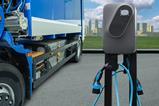Volvo Trucks has succesfully completed crash testing on its electric vehicles, the company has announced.
“Volvo’s electric trucks have the same cabs as our traditional diesel trucks, which have been thoroughly tested to ensure they are crashworthy. The electric trucks also have the same advanced safety features that are designed to prevent accidents from happening in the first place,” says Anna Wrige Berling, Safety Director at Volvo Trucks.
Battery electric trucks provide unique safety difficulties, primarily due to the electromobility system, which comprises a 600V battery. The possibility of shortcuts and chemical leaks from the system must be reduced. Volvo employs rigorous calculations, virtual simulations, and full-scale crash testing to ensure the safety of its electric trucks in the case of a collision.

The tests imitate real-world traffic circumstances in order to validate electrical, chemical, and fire safety standards. The Volvo FM Electric successfully completed three types of full-scale crash tests. The results of the tests confirm the positive results from the virtual simulations.
Side collision test. A trolley, representing a passenger automobile, slams into the side of the truck, where the batteries are placed, in this test. The test confirms that battery packs, including their modules and cells, are properly protected and remain in place even when subjected to high stress.
Roll-over test. The vehicle is forced to turn over in this situation, which is a regular truck accident. The goal is to ensure that the high voltage system is turned off in order to reduce the hazards to the driver and the rescue crew.
Barrier test. The barrier test involves the vehicle colliding with a barrier, mimicking the back of another truck. The electric truck is examined to ensure that the electric installations and components beneath the cab remain in place and that there are no shortcuts that may lead to a fire or other hazardous condition.


















